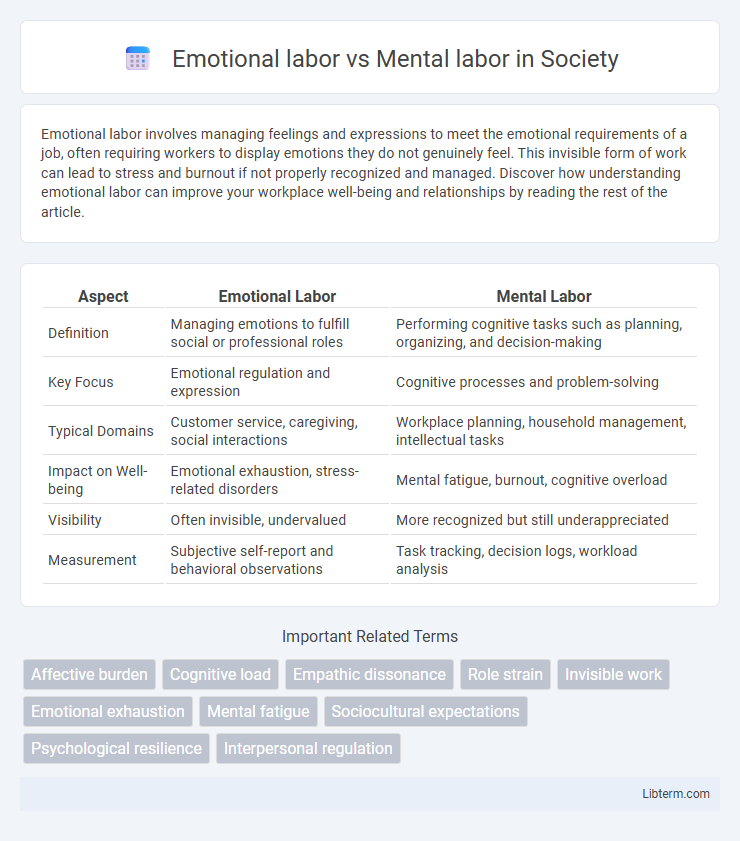Emotional labor involves managing feelings and expressions to meet the emotional requirements of a job, often requiring workers to display emotions they do not genuinely feel. This invisible form of work can lead to stress and burnout if not properly recognized and managed. Discover how understanding emotional labor can improve your workplace well-being and relationships by reading the rest of the article.
Table of Comparison
| Aspect | Emotional Labor | Mental Labor |
|---|---|---|
| Definition | Managing emotions to fulfill social or professional roles | Performing cognitive tasks such as planning, organizing, and decision-making |
| Key Focus | Emotional regulation and expression | Cognitive processes and problem-solving |
| Typical Domains | Customer service, caregiving, social interactions | Workplace planning, household management, intellectual tasks |
| Impact on Well-being | Emotional exhaustion, stress-related disorders | Mental fatigue, burnout, cognitive overload |
| Visibility | Often invisible, undervalued | More recognized but still underappreciated |
| Measurement | Subjective self-report and behavioral observations | Task tracking, decision logs, workload analysis |
Understanding Emotional Labor: Definition and Examples
Emotional labor involves managing and regulating emotions to fulfill the emotional requirements of a job, such as customer service roles where employees must display friendliness regardless of personal feelings. It differs from mental labor, which encompasses cognitive tasks like planning, decision-making, and problem-solving. Examples of emotional labor include flight attendants maintaining calm and cheerful demeanors during stressful flights and teachers providing emotional support to students while managing classroom dynamics.
What Is Mental Labor? Key Concepts and Scope
Mental labor refers to the cognitive effort involved in planning, organizing, and managing tasks, often related to anticipatory thinking and decision-making. Key concepts include information processing, strategic problem-solving, and the invisible management of responsibilities that require sustained attention and mental energy. The scope of mental labor extends beyond routine tasks to encompass emotional regulation, multitasking, and the continuous mental juggling necessary to coordinate both personal and professional domains.
Emotional Labor vs Mental Labor: Core Differences
Emotional labor involves managing and regulating feelings to fulfill the emotional requirements of a job, such as customer service or caregiving, while mental labor refers to the cognitive effort involved in planning, organizing, and problem-solving tasks. Core differences lie in emotional labor's impact on psychological well-being due to constant emotional regulation, whereas mental labor primarily affects cognitive load and decision-making capacity. Understanding these distinctions highlights the unique stressors and resource demands associated with each type of labor in professional and domestic settings.
Historical Context: Evolution of Labor in the Workplace
Emotional labor emerged as a concept in the 1980s to describe the regulation of emotions required in service-oriented jobs, contrasting with mental labor, which involves cognitive tasks like planning and decision-making. Historically, mental labor was linked to white-collar professions, while emotional labor was predominantly recognized in roles with customer interaction, often occupied by women. The evolution of workplace dynamics has blurred these distinctions, highlighting how both forms of labor contribute significantly to productivity and worker well-being across various industries.
Gender Dynamics in Emotional and Mental Labor
Emotional labor involves managing one's emotions and the emotions of others to maintain social harmony, often disproportionately expected from women in both professional and domestic settings. Mental labor refers to the cognitive efforts in planning, organizing, and problem-solving, which women frequently undertake invisibly within household management. Gender dynamics reveal that women bear a dual burden of emotional and mental labor, reinforcing systemic inequalities in workload distribution and affecting their mental health and career progression.
Emotional Labor Across Professions: Who Feels It Most?
Emotional labor, defined as managing feelings to fulfill the emotional requirements of a job, is most intensely experienced by professions with high customer interaction, such as healthcare workers, teachers, and service industry employees. Mental labor, involving cognitive tasks like planning and decision-making, often overlaps with emotional labor but remains distinct in jobs requiring sustained concentration, such as managerial roles and technical professions. Studies highlight that emotional labor is disproportionately felt by female-dominated professions, amplifying workplace stress and burnout risks.
Mental Labor in Modern Workplaces: Invisible Burdens
Mental labor in modern workplaces manifests as continuous cognitive effort involved in planning, decision-making, and managing tasks, often remaining invisible and unrecognized despite its critical role in productivity. This invisible burden includes organizing schedules, anticipating problems, and coordinating with colleagues, which consumes substantial mental energy beyond physical or explicit job duties. Employers who acknowledge and address mental labor foster healthier work environments by implementing strategies that distribute cognitive responsibilities and reduce employee burnout.
The Psychological Impact of Emotional and Mental Labor
Emotional labor involves managing feelings to fulfill job requirements, often leading to stress, burnout, and emotional exhaustion due to constant emotional regulation. Mental labor encompasses cognitive tasks such as planning, decision-making, and problem-solving, which can cause cognitive overload, anxiety, and decreased productivity when excessive. Both types of labor impact psychological well-being by contributing to fatigue and impairing mental health, highlighting the importance of balance and support strategies in workplaces.
Coping Strategies: Managing Emotional and Mental Labor
Effective coping strategies for managing emotional labor include practicing mindfulness, setting clear boundaries, and engaging in regular self-care routines to reduce stress and prevent burnout. Mental labor management benefits from prioritizing tasks, delegating responsibilities, and using organizational tools like planners or digital apps to enhance cognitive efficiency. Combining these approaches fosters resilience, improves emotional regulation, and supports overall mental well-being in demanding environments.
Redefining Labor: Creating Supportive Work Environments
Emotional labor involves managing feelings and expressions to fulfill job requirements, often seen in customer service roles, while mental labor encompasses cognitive tasks such as planning, problem-solving, and decision-making. Redefining labor requires recognizing both forms as essential contributions, fostering supportive work environments through policies that address emotional well-being and cognitive workload. Implementing training on emotional intelligence and providing resources for mental health support enhances productivity and employee satisfaction.
Emotional labor Infographic

 libterm.com
libterm.com